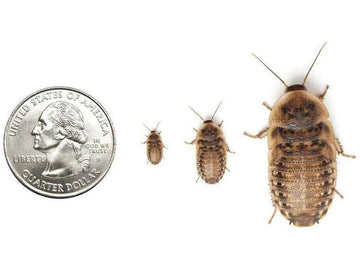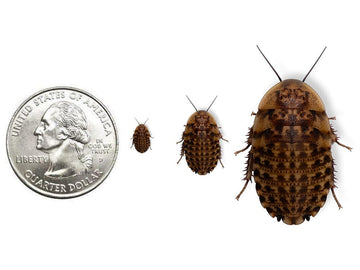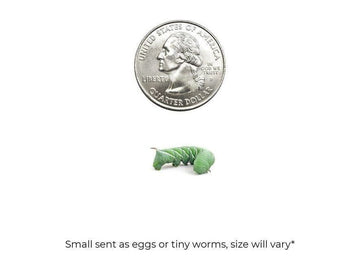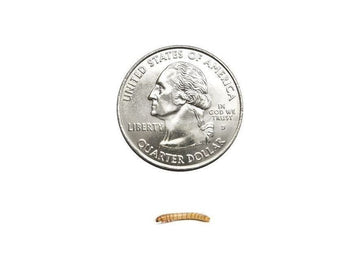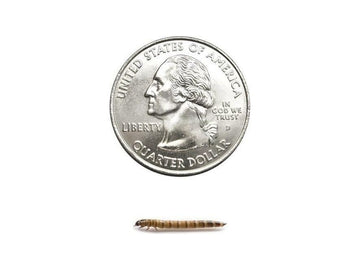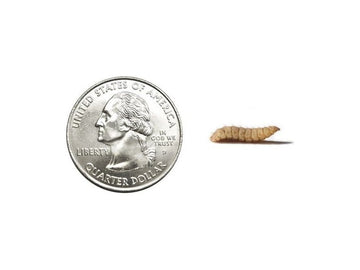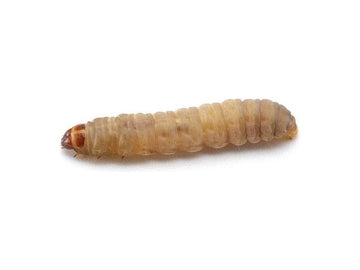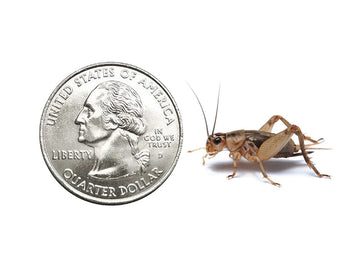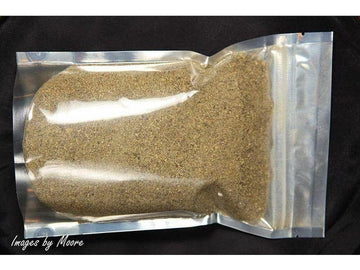The Peter's banded skink (Scincopus fasciatus) is a 5-7” long, nocturnal, fossorial lizard native to the Sahel region of Africa. They prefer habitat with sandy soil and arid conditions, and have been observed in scrub to dry grasslands.
Peter's banded skinks are fairly stout-bodied for skinks, with a tapered head, large black eyes, short limbs, short digits, smooth scales, and a tapered tail. Coloring is orange on top and cream on bottom, with broad black stripes across their back and tail.
Little concrete information is available about caring for Peter's banded skinks along with there being no captive bred individuals available, so this is an advanced-level pet reptile.
Minimum recommended terrarium size for Peter's banded skinks
The minimum terrarium size we recommend for a Peter's banded skink is about 36”L x 18”W x 18"H. Of course, larger is always better — if you provide, they will use it!
Housing multiple Peter's banded skinks is not recommended, as they do not appear to be a naturally social species.
Do Peter's banded skinks need UVB?
Peter's banded skinks are nocturnal, so they may be able to survive without UVB lighting as long as proper vitamin D3 supplementation is provided. Since we don't know how much they truly need, it’s safest and best practice to provide appropriate UVB lighting. UVB lighting helps provide a clear day/night cycle, provides all of the vitamin D that your skink needs, strengthens the immune system, facilitates better digestion, and other benefits.
The best UVB bulbs for Peters banded skinks are:
The brands we recommend here have "kits" available that come with the proper fixture. If not, be sure your fixture has a reflector. Also be sure that the fixture your UVB bulb is housed in does not have a clear plastic bulb cover, as plastic and glass block UVB.
Most people do a 12 hours on and 12 hour off lighting schedule. However, you can also do longer times on during the summer and shorter times on in the winter to mimic the actual sun.
Best temperature for Peter's banded skinks
Peter's banded skinks should have a basking temperature of 90-95°F, cool side temperature between 70-75°F, and nighttime temps around 65°F or higher. You want to turn off all heat sources at night. Basking and surface temperatures can be measured with a temperature gun. A digital probe thermometer on the warm and cool side is best to monitor temperatures on both sides.
It is suggested to provide heat for your skink with a combination of a heat mat and heat bulb. We do not recommend ceramic heat emitters (CHEs), red bulbs, or blue bulbs, as these are not as effective. The heat mat is for keeping the warm hide at the right temperature, and it requires a thermostat with the probe placed inside the warm hide. Please be aware, you cannot use a heat mat if you are using a PVC enclosure, it is not safe. Above head heating and lighting is perfectly fine if you are using PVC.
The heat lamp and UVB should be placed on one side of the enclosure, with the warm hide directly below. A heat mat is only necessary if the heat lamp doesn’t get the warm hide to a high enough temperature. If the heat lamp is too warm (basking area over 100°F), dim it with a plug-in lamp dimmer or rheostat. If it is too cool, you want a higher-wattage bulb.
Recommended humidity levels for Peter's banded skinks
There is little information on what humidity they truly need. Based on where they are from, we recommend an average humidity below 50%, as measured by a digital probe hygrometer with the probe in the middle of the terrarium.
Best substrate for Peter's banded skinks
Since they spend a good amount of time digging and underground, they do best with a layer of substrate at least 3"-4” deep. Some substrates so consider are:
- Zoo Med ReptiSand
- Exo Terra Desert Sand
- Exo Terra Stone Desert
- Sand/soil mixture
We recommend keeping about half of the substrate damp - but not oversaturated - and half very dry to give your skink various substrate options. To keep the substrate clean and your lizard healthy, remove old food and waste every day, along with contaminated substrate. You will need to completely remove and replace your substrate every 3-4 months.
How to decorate a Peter's banded skink terrarium
Am empty enclosure is boring to look at and stressful for your skink to live in. Make the most of your terrarium by adding a variety of enrichment items for your pet to climb and explore. Here are some ideas:
- climbing logs/branches
- caves
- live or artificial plants
- rocks
If you are using a tank or aquarium, we recommend you cover three sides of the enclosure to help your pet feel more secure in its home.
What to feed to a Peters banded skink
Peters banded skinks are primarily insectivorous, which means that they eat mostly insects and other invertebrates. However, they are also known to eat some plants as well. Do not stress out if your skink does not eat plants, it seems not all individuals will eat them. It is still good to offer it regardless. Here’s a basic feeding schedule for your pet Peters banded skink:
- Juveniles — Insects daily, plants daily
- Adults — Insects every 2-3 days, plants daily
Variety is the key to providing a healthy, balanced diet for your Peter's banded skink. The more variety you can provide, the better!
Feeder insect options for Peters banded skinks: dubia roaches, discoid roaches, crickets, grasshoppers, black soldier fly larvae, hornworms, silkworms, mealworms, superworms
Vegetable options for Peters banded skinks: collard greens, turnip greens, mustard greens, endive, kale, spring mix, dandelion greens, alfalfa, cactus pads, squash, shredded carrots
Supplements
You will also need calcium and vitamin supplements to prevent your skink from developing a deficiency. This is our recommended schedule for supplementing a Peter's banded skink:
Every feeding: (one) calcium without D3
1x/week: (one) multivitamin
Water
Of course, don’t forget a medium to large water bowl for your Peter's banded skink to drink from! Change the water daily and scrub the bowl with a reptile-safe disinfectant weekly, or whenever it becomes soiled.
How to handle your Peter's banded skink
Reptiles generally don’t appreciate petting and handling in the same way that dogs and cats do. Peter's banded skinks, however, are known for being quite docile and tolerate handling better than a lot of other reptiles. Here are some tips for success:
- Start with tong-feeding.
- Don’t grab the skink from above. Instead, scoop from below.
- Whenever possible, let the skink come to you rather than chasing after it.
- Support as much of its body as possible, especially the feet.
- Start with short handling sessions at first, then gradually make them longer.
- Put the lizard back in its enclosure only when it’s calm.
*This care sheet contains only very basic information. Although it’s a good introduction, please further your research with high-quality sources. The more you know, the better you will be able to care for your pet!


